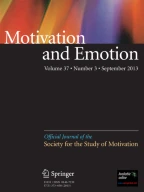Abstract
Subjects viewed eight short film segments and rated the strength of their responses within eight emotion categories. Principal-components analysis showed that these ratings varied along three dimensions: Amused-Warmhearted, Fearful-Anxious, and Disgusted-Scornful. Clusters of film segment centroids occupied distinct regions within this reduced space, and moderate homogeneity was found when the individual ratings were assigned to the centroids of these clusters. Further analyses concerned the reliability of the ratings over time, the effects of prior exposure, and sex differences. Ratings obtained on a subset of these film segments during a subsequent psychophysiological experiment were analyzed to test the generalizability of the results of Study 1. The factor patterns were very similar, as were tests for the homogeneity of the ratings. The structure of self-reports of elicited affect and the utility of film stimuli are discussed.
Similar content being viewed by others
References
Abelson, R. P., & Sermat, V. Multidimensional scaling of facial expressions.Journal of Experimental Psychology 1962,63 546–554.
Anderberg, M. R.Cluster analysis for applications. New York: Academic Press, 1973.
Averill, J. R. A semantic atlas of emotional concepts.JSAS Catalogue of Selected Documents in Psychology 1975,5 330. (Ms. No. 421)
Axelrod, J. Induced moods and attitudes toward products.Journal of Advertising Research 1963,3 19–24.
Bush, L. E., II. Individual differences in multidimensional scaling of adjectives denoting feelings.Journal of Personality and Social Psychology 1973,25 50–57.
Dittman, A. T.Interpersonal messages of emotion. New York: Springer, 1972.
Ekman, P., Friesen, W. V., & Ancoli, S. Facial signs of emotional experience.Journal of Personality and Social Psychology 1980,39 1125–1134.
Ekman, P., Friesen, W. V., & Ellsworth, P.Emotion in the human face. New York: Permagon Press, 1972.
Green, R. S., & Cliff, N. Multidimensional comparisons of structures of vocally and facially expressed emotions.Perception and Psychophysics 1975,17 429–438.
Hendrick, C., & Lilly, R. S. The structure of mood: A comparison between sleep deprivation and normal wakefulness conditions.Journal of Personality 1970,38 453–465.
Izard, C. E.The face of emotion. New York: Appleton-Century-Crofts, 1971.
Izard, C. E.Patterns of emotions. New York: Academic Press, 1972.
Johnson, S. C. Hierarchical clustering schemes.Psychometrika 1967,32 241–254.
Lazarus, R. S., & Alfert, E. Short-circuiting of threat by experimentally altering cognitive appraisal.Journal of Abnormal and Social Psychology 1964,69 195–205.
Lazarus, R. S., Speisman, J. C., Mordkoff, A. M., & Davison, L. A. A laboratory study of psychological stress produced by a motion picture film.Psychological Monographs, 1962,76, (34, Whole No. 553).
Levison, C. A. Perceived similarity and the judgement of mood in others.Journal of Social Psychology 1963,61 99–110.
McNair, D. M., & Lorr, M. An analysis of mood in neurotics.Journal of Abnormal and Social Psychology 1964,69 620–627.
Meddis, R. Bipolar factors in mood adjective checklists.British Journal of Social and Clinical Psychology 1972,11 178–184.
Nowlis, V. Research with the Mood Adjective Check List. In S. S. Tomkins & C. E. Izard (Eds.),Affect, cognition, and personality. New York: Springer, 1965.
Nowlis, V., & Green, R. F.Factor analytic studies of mood. Technical Report, Office of Naval Research: Contract No. Nonr-668(12), 1964.
Nowlis, V., & Nowlis, H. H. The description and analysis of mood.Annals of the New York Academy of Sciences 1956,65 345–355.
Osgood, C. E. Dimensionality of the semantic space for communication via facial expressions.Scandinavian Journal of Psychology 1966,7 1–30.
Osgood, C. E. On the whys and wherefores of E, P, and A.Journal of Personality and Social Psychology 1969,12 194–199.
Osgood, C. E., Suci, G. J., & Tannenbaum, P. H.The measurement of meaning. Urbana: University of Illinois Press, 1957.
Polivy, J. On the induction of emotion in the laboratory: Discrete moods or multiple affect states?Journal of Personality and Social Psychology 1981,41 803–817.
Plutchik, R.Emotion: A psychoevolutionary synthesis. New York: Harper & Row, 1980.
Royal, D. C., & Hays, W. L. Empirical dimensions of emotional behavior.Acta Psychologica 1959,15 419.
Russell, J. A. Evidence for convergent validity on the dimensions of affect.Journal of Personality and Social Psychology 1978,36 1152–1168.
Russell, J. A. Affective space is bipolar.Journal of Personality and Social Psychology 1979,37 345–356.
Russell, J. A. A circumplex model of affect.Journal of Personality and Social Psychology 1980,39 1161–1178.
Russell, J. A., & Mehrabian, A. Evidence for a three-factor theory of emotions.Journal of Research in Personality 1977,11 273–294.
Schlosberg, H. The description of facial expressions in terms of two dimensions.Journal of Experimental Psychology 1952,44 229–237.
Schlosberg, H. Three dimensions of emotion.Psychological Review 1954,61 81–88.
Shepard, R. N. The analysis of proximities: Multidimensional scaling with an unknown distance function.Psychometrika 1962,27 125–139; 219–246.
Snider, J. G., & Osgood, C. E.Semantic differential technique. Chicago: Aldine, 1969.
Speisman, J. C., Lazarus, R. S., Mordkoff, A., & Davison, L. Experimental reduction of stress based on ego-defense theory.Journal of Abnormal and Social Psychology 1964,68 367–380.
Thayer, R. E. Measurement of activation through self-report.Psychological Reports 1967,20 663–678.
Tourangeau, R., & Ellsworth, P. C. The role of facial response in the experience of emotion.Journal of Personality and Social Psychology 1979,37 1519–1531.
Zuckerman, M., Klorman, R., Larrance, D. T., & Spiegel, N. H. Facial, autonomic, and subjective components of emotion: The facial feedback hypothesis versus the externalizer-internalizer distinction.Journal of Personality and Social Psychology 1981,41 929–944.
Author information
Authors and Affiliations
Additional information
This research was supported by National Science Foundation Grant 77-08926 and by funds from the Lincoln Filene endowment to Dartmouth College.
Rights and permissions
About this article
Cite this article
McHugo, G.J., Smith, C.A. & Lanzetta, J.T. The structure of self-reports of emotional responses to film segments. Motiv Emot 6, 365–385 (1982). https://doi.org/10.1007/BF00998191
Issue Date:
DOI: https://doi.org/10.1007/BF00998191
